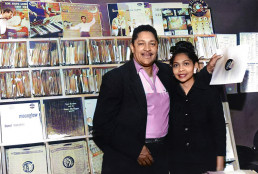
Jeanette Baker knew who John Dolphin was when during her time as a young high school artist in the 1950s.
“I can see him presently strolling around with that stogie,” Baker says. “At the point when he strolled around, you realized he was someone. He had that air about him, which was somewhat uncommon in those days because being a person of color with all the fitness that he had, he became a good example to us.”
Before Berry Gordy founded the Motown record label, John Dolphin ran his own record mark, Recorded in Hollywood. It was related to his earth-shattering record shop in South Central Los Angeles and the public broadcasts that it transmitted, helping such musicians as jazz performer Charles Mingus and a young Sam Cooke reach the city’s white audience (and beyond). John Dolphin’s story is currently playing to sold-out crowds in Los Angeles as Recorded In Hollywood: The Musical, and is moving to another venue in one month’s time.
Dolphin’s store existed off Central Avenue — the fundamental Los Angeles drag for people of color in those days.
“Going north on Central, there was the Club Alabam, The Last Word, The Memo,” Baker says. “You could also find the Lincoln Theater. It saddens me that we didn’t protect that, since that is the place where all the bigger performing acts played — all the shows, and so on…everyone was there. You know, Cab Calloway, every one of them were there.”
It wasn’t Dolphin’s original intention to open his record store in South Central. Originally, Dolphin attempted to lease space on Sunset Boulevard in Hollywood from a white finance manager. He had the capital, but had no credit. He had references, but none of them held weight in Hollywood.
That didn’t stop Dolphin from opening his record store, which he brought to South Central, intentionally calling it Dolphin’s of Hollywood. It was 1948, and he had huge thoughts for a record shop, according to Phil Gallo, who’s put down a book on the historical backdrop of account stores.
“He thought of the possibility of the 24-hour store, which practically didn’t exist,” Gallo says. “He had put a radio broadcast within the record store. Additionally, he had to develop a name that would stream out the record store.”
Dolphin had well-known white DJs turning records throughout the night at the storefront’s enormous retail window. He purchased broadcast appointments on the KRKD radio station, which took into account white audience members. They played Dolphin-delivered records and melodies by others. On top of that, the hybrid allure of these broadcasts helped break a couple of melodies broadly.
“Aficionados, all things considered,” Gallo says, “started visiting the store from all over the city. He had stopped, so individuals could hang out in that parking lot, hear the radio broadcast, go inside the store, buy or make a couple of records, return outside, and hang out. He managed to establish a scene, and it consisted of music fans. From small children to adults alike, people flocked to the store from all over.”
In any event, the store’s prevalence turned out to be a little too much to handle for specialists, according to Matt Donnelly, who co-wrote Recorded In Hollywood: The Musical.
“They were stressed about younger white women hitting the dance floor with dark young men, so decide to make captures, sending the white children home,” Donnelly says. “And afterward, no doubt, they would periodically close down the shop.”
Dolphin was even captured, as the musical portrays. Yet, he managed to re-open and remain a fruitful finance manager.
Well, he did until Feb. 1, 1958, when a hopeful vocalist and long-lasting store worker named Percy Ivy became vexed because Dolphin wouldn’t offer him a record arrangement. Ivy shot Dolphin in the store.
“You know, it made me extremely upset when he got killed,” says Baker, who found out about the killing the very next day. “It upset everyone. I want to cry now just thinking about it because we knew right then and there that our reality had changed.”
Dolphin’s widow, Ruth, kept the store alive in 1989. “It’s crazy to think that only a select few individuals today recall the store or its proprietor,” says John Dolphin’s grandson, Jamelle Dolphin. When he was growing up, he says individuals would consistently ask if he was related as to the celebrated record storekeeper.
“Furthermore, this would be something I sort of became attached to,” Jamelle Dolphin says. “It was normal, but then it just stopped around the 1990s and 2000s. Lastly, I think he ought to be a more significant piece of the historical backdrop of music in Los Angeles than what he is today.”
So Jamelle wrote a book about his grandfather that turned into the reason for the new musical. Jamelle Dolphin also co-composed the content with Donnelly, and the music and verses are by Andy Cooper from the hip-jump bunch Ugly Duckling.
John Dolphin “was a business person,” Donnelly says. “He was a visionary. He was, as James Brown put it, the principal individual of color to be fruitful in the music business. Also, he’s someone who should be remembered.”
Donnelly and Jamelle hope Recorded In Hollywood will help revive the memory of John Dolphin.
ROBERT SIEGEL, HOST:
Before Berry Gordy conceived Motown, John Dolphin had his own record name, Recorded in Hollywood. He owned a mainstream record store that was tucked away in South Central Los Angeles, and it broadcast public radio broadcasts from the store. That entire scene and radio broadcast presented Sam Cooke’s music to the city’s white audiences. Dolphin’s story is presently playing to sold-out theater crowds in Los Angeles and Iris Mann investigates “Recorded In Hollywood: The Musical.”
IRIS MANN, BYLINE: Jeanette Baker became more acquainted with John Dolphin when she was an artistic, adolescent vocalist in the 1950s.
JEANETTE BAKER: I can see him in my mind strolling around with that stogie. Also, when he strolled around, you realized he was someone. He had that air about him, which was uncommon for a person of color in those days. In any case, he made a good example to us.
MANN: Baker would hang out at Dolphin’s store, which was simply off Central Avenue, the primary drag for people of color in Los Angeles in those days.
Bread cook: Going north on Central, there was the Club Alabam, The Last Word, The Memo, and the Lincoln Theater. Makes me extremely upset that we didn’t protect that since that is the place where all the large groups went, all the shows, and so on – Cab Calloway – every one of them was there.
MANN: But that is not where John Dolphin needed to open his record store. Right off the bat in the melodic, he attempts to lease space on Sunset Boulevard in Hollywood from a white financial specialist who turns him down.
UNIDENTIFIED ACTOR: (As white finance manager) It has nothing to do with the shade of your skin.
STU JAMES: (As John Dolphin) Don’t consider me an individual of color. Consider me for what I am – a money manager.
UNIDENTIFIED ACTOR: (As white money manager) If you’ll pardon me, I’m late for another arrangement. Would you take a gander at that? I do apologize Mr. Dolphin.
JAMES: (As John Dolphin) I don’t need your statement of regret, I need a rent. Hollywood. Man, I needn’t bother with Hollywood. Hollywood necessities me.
MANN: So Dolphin opened his store in South Central and called it Dolphin’s of Hollywood. It was 1948 and he had large thoughts for a record shop, says Phil Gallo, who’s set up a book on the historical backdrop of account stores.
PHIL GALLO: He concocted the possibility of the 24-hour store, which didn’t exist. He had to put a radio broadcast within a record store. Also, he had a mark that produces out of the record store.
MANN: Dolphin had mainstream white DJs turning records the entire night in the huge retail facade window. He purchased broadcast appointments on radio broadcast KRKD, which took into account white audience members. They played Dolphin-delivered records and melodies by others. Furthermore, the hybrid allure of the shows helped break a couple of tunes broadly.
THE PENGUINS: (Singing) Earth heavenly messenger, earth heavenly messenger, will you be mine?
MANN: Fans of all tones started dropping on the store from across the city, says Phil Gallo.
GALLO: He had to stop so individuals could hang out in that parking area, hear the radio broadcast, go into the store, make a buy or two, return outside and hang out. What’s more, that was truly what was critical. There was a scene that was created and it was simply music fans, and it was little youngsters. What’s more, they came from everywhere.
MANN: But the store’s prevalence turned out to be a lot for the specialists, says Matt Donnelly, who co-expressed “Recorded In Hollywood: The Musical.”
MATT DONNELLY: They were stressed over white young ladies hitting the dance floor with dark young men, thus they would make captures, send the white children home, and afterward they would once in a while shut down the shop.
MANN: John Dolphin has even captured himself, however, he generally re-opened and stayed an effective money manager…
JAMES: (As John Dolphin) When John Dolphin talks in the class, it’s the gospel, infant. So I need you to check this down at the present moment so you can recollect that I told you all (singing) I will make it, I will aim high.
MANN: …Until February 1, 1958. On that day, hopeful vocalist Percy Ivy, a long-lasting store worker, became disturbed when Dolphin wouldn’t offer him a record arrangement and chance the storekeeper to death. Vocalist Jeanette Baker says she caught wind of it the following day.
Cook: It made me extremely upset when he got murdered. It made’s everybody extremely upset. I want to cry now since all the craftsmen, realized that right then and there, our reality had changed.
MANN: Dolphin’s widow, Ruth, kept the store going until 1989. In any case, barely any individuals today recollect the store or its proprietors, says John Dolphin’s grandson, Jamelle. At the point when he was growing up, he says, individuals would inquire as to whether he was identified with the well-known record storekeeper.
JAMELLE DOLPHIN: And this would be something I sort of became partial to, and it just quit occurring around, say, the 1990s and 2000s. Furthermore, I began delving more into, you know, how he helped Los Angeles and how he helped mix and uniting individuals with music. Thus I just turned out to be more enthusiastic about his story, and I felt that it ought to be considerably more a piece of the historical backdrop of music in Los Angeles than what he is present.
MANN: So he composed a book about his granddad that turned into the reason for the new melodic, which Dolphin additionally co-composed with Matt Donnelly.
DONNELLY: He was relatively revolutionary, he was a business person, he was a visionary. He was, as James Brown put it, the main person of color to be fruitful in the music business. Furthermore, it’s somebody that should be recalled.
MANN: And Donnelly and Jamelle Dolphin trust “Recorded In Hollywood: The Musical” will help resuscitate that memory. For NPR News, I’m Iris Mann. The record is given by NPR, Copyright NPR.
